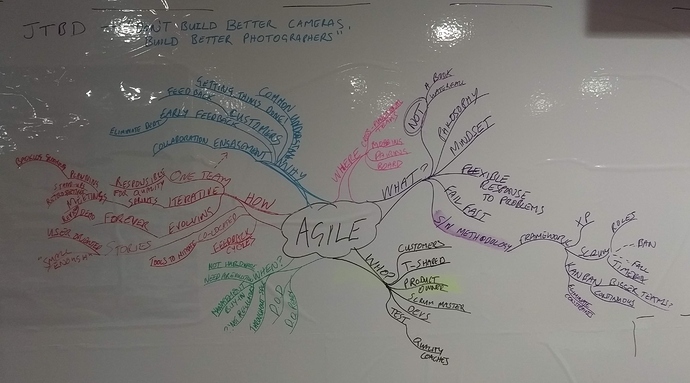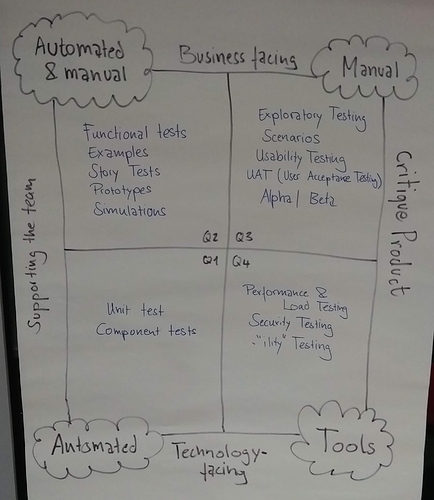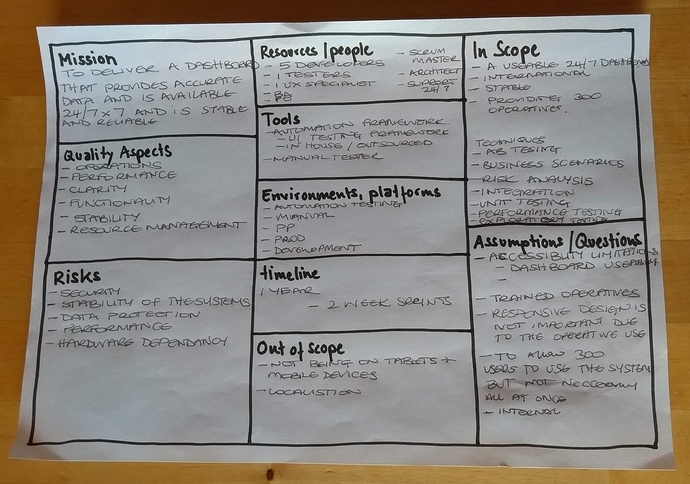Hi everybody,
we had a fantastic session on “Testing in Agile” with lively discussions around all things Agile and a hands on exercise where we were diving into test planning and strategy - keeping the big picture view for testing in an Agile environment. Thanks to all attendees for contributing fantastically and to DisplayLink for hosting!
A quick wrap up on the session, with tips on further reading and resources:
We started off collaborated on a Mind Map about all things Agile, structured via the Five W’s (and one H):
For a similar Mind Map compare to:
We zoomed in on Testing in Agile by looking at the Agile Testing Quadrants by Lisa Crispin and Janet Gregory:
You can find more on Agile (and the Agile Testing Quadrants) here:
- Lisa Crispin: Using the Agile Testing Quadrants
- Lisa Crispin, Janet Gregory: Agile Testing
- Lisa Crispin, Janet Gregory: More Agile Testing
- Theory of Constraints
In the second part of the session, we got hands on with Test Planning and Strategy in Agile. We use Test Plan here as a kick off for discussion and want to treat it as a living document that is changed and adapted as you go along and learn more about your customers, the project, what’s required and what the risks are.
The Task for the exercise:
Your context
You’re working in an agile team - five developers, one tester and there is also a UX specialist, business analyst, PO and scrum master accessible.You’ll be working on
A new dashboard for a call center. The call center is being contacted by email, SMS and telephone. The dashboard is supposed to show the status of email, SMS and phonecall queues, statistics, trends and activities right now, as well as direct to which of the queues to cover next. The call center operates in English only, 24/7 on 7 days a week, with offices around the world. There are a about 300 operatives to answer 4000 calls a day, 6000 emails and 300 text messages.
And the Exercise, in the style of a mini Risk Storming session:
Exercise:
- Identify 6 most relevant Quality Aspects for your feature (Blue TestSphere cards)
- Brainstorm on risks, reflect on assumptions
- Select testing techniques you want to apply (Green TestSphere cards, Agile Testing Quadrants)
- Take notes, fill in the example One-Page-Testplan as you go along.
We gave a template for a One-Page Testplan. See as example one of the Test Plans the groups created:
Find out more on Test Plan, Test Strategy and Risk Storming:
- Beren van Daele & Ministry of Testing: TestSphere
- Marcel Gehlen: RiskStorming - Maping Risks with TestSphere
- Claire Reckless: The One Page Test Plan
- Richard C Paterson: How To Write A Software Test Plan
- Michael Bolton: Blog: What Should a Test Plan Contain?
- James Whittaker: The 10 Minute Test Plan
If you want to dig deeper into the topic of Agile Testing, the “30 Days of Testing” series from Ministry of Testing is a great way to explore a wide range of perspectives on a given area. Try the one for Agile:
Are there any other resources you would recommend? Have you used any of the above mentioned models, methods or strategies?
Keep exploring, questioning and discussing!
Many thanks,
Karo & Mark


